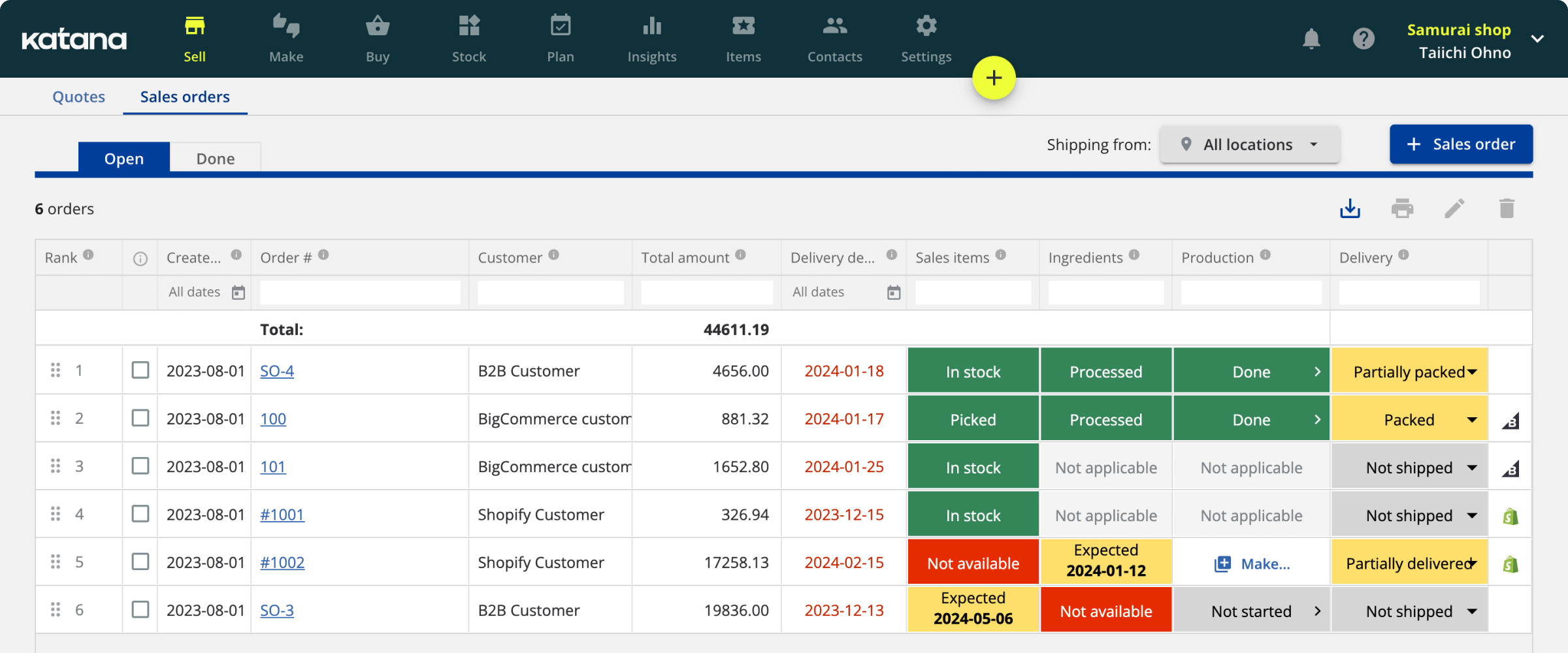Demand planning: How to properly forecast your sales
Crystal balls are brilliant — they let you know what will happen in the future so you can act accordingly.
It’s sad that they only exist in fairy tales and stage shows. Unfortunately, there are no crystal balls in the business world, so you have to resort to other methods to predict your sales and plan accordingly.
The next best thing is demand planning.
This article will cover everything you need to know about demand planning and forecasting and how it can better prepare you for future sales. So, unless you have some pressing plans for this very moment, make yourself comfy as we dive into the world of demand planning.
What is demand planning?
Demand planning is the process of forecasting, monitoring, and managing customers’ demand for a product or a service while taking into account market conditions, consumer preferences, and other external factors. By understanding the future demand for their products, businesses can better plan supply and production to meet customer needs.
Demand planning tools allow businesses to use historical data and insights from analytics to make more informed decisions about how much product they need to produce or purchase to meet customer needs. This helps them ensure that there are enough products available at the right time and place in order to maximize sales opportunities and avoid unnecessary costs associated with over-production or under-stocking.
10 reasons why demand planning is important
Returning to the crystal ball analogy — a good demand plan is the closest you can get in the real world. But let’s go over the specific benefits it brings.
1. Competitive advantage in the marketplace
Demand planning is crucial for businesses to succeed in a competitive market. Understanding product demand and forecasting consumer trends enables companies to efficiently plan their supply chain, minimize costs, and meet customer demand effectively.
2. Efficient supply chain management
By forecasting demand accurately, businesses can create more efficient processes within their supply chain. This helps minimize costs and ensures that customers receive what they want, when they want it, and at the lowest possible cost.
3. Enhanced strategy
Utilizing demand planning tools allows businesses to gain insights into the market, understand customer preferences, and create plans to anticipate changes in demand or supply. This strategic adjustment helps companies stay competitive and maximize profits.
4. Risk management
Demand planning is integral to risk management, mitigating issues related to overproduction, underproduction, or resource misallocation. This helps in managing inventory levels and ensuring business continuity during market fluctuations.
5. Resource optimization
Through demand planning, resources, including manpower, machinery, and capital, are allocated more efficiently. This leads to increased productivity and cost savings, preventing the waste of resources on low-demand products.
6. Customer satisfaction and loyalty
Meeting customer demand accurately and promptly enhances customer satisfaction, fostering loyalty. Repeat customers are vital for long-term business success and contribute significantly to revenue.
7. Data-driven decision making
Advanced analytics and big data in demand planning lead to more accurate forecasting and deeper insights. This enables more informed decision-making, leveraging AI and machine learning technologies.
8. Market trend analysis
Demand planning is key in analyzing and predicting market trends, aiding companies in strategic planning, and staying ahead in product development and innovation.
9. Supply chain agility
Effective demand planning improves supply chain agility, allowing companies to quickly adapt to demand changes, reducing lead times, and enhancing overall responsiveness.
10. Environmental impact
Aligning production with actual demand through effective demand planning reduces waste and minimizes environmental impact, aligning with sustainability goals and regulatory requirements.
Safeguard your business against disruptions
Based on proprietary data and external sources, we’ve compiled a checklist to help businesses demand plan and prepare for uncertainty in 2024.
What is the difference between demand forecasting and demand planning?
Demand planning and forecasting are both crucial elements of effective supply chain management. While they are related, the two terms refer to distinct processes that help businesses manage their inventories efficiently.
Demand planning is an ongoing process that includes setting business goals and strategies, identifying demand drivers, understanding customer needs, analyzing historical data, developing forecasts, and creating replenishment plans — all to meet customer demand while minimizing costs. Demand planning aims to ensure that companies have the right products in the right places at the right times.
On the other hand, demand forecasting looks at past sales trends and predicts what will happen based on those patterns. It involves looking for patterns in historical data, such as sales figures and customer demand, and then using those patterns to create forecasts for the future. Forecasting is important as it helps companies anticipate market changes so they can adjust their strategies accordingly.
Know the difference
- Demand forecasting — Predicting what the demand for a certain product or service will be in the future
- Demand planning — Planning and organizing the resources, activities, and operations necessary to meet future customer demand
Demand forecasting methods
Demand forecasting methods help organizations forecast and plan for their future needs. These methods enable businesses to accurately anticipate customer demand. Here are some of the most common demand forecasting methods.
Market expert
Ask the experts.
We’ve all heard that before. You can use your portfolio of expert contacts to fill out a survey on their opinions on demand forecasts in your industry, and you can even get product-specific.
This method requires some solid connections to be in place, but the cool thing is that it’s easy to do. Little statistical knowledge is required. Just make sure you have a big enough sample size of experts and that they are contacted separately.
Collusions between those who give answers might seem like a good thing, but it’s always best to first ask separately so you don’t create a discussion bubble.
Consumer survey
This approach might seem too simple to be true.
Just ask your customers what they plan on buying in the future. There’s no one better to ask about requirements and needs than your customers. As an additional benefit, it shows your customers that you’re interested in their feedback and want to understand their needs better.
Just be aware that although you can draw on the data, this method is more supplementary than others. It’s good to get a solid base using multiple methods, so you don’t get stuck on one angle.
Pro tip: A great plan starts with a great forecast. To make sure your predictions are accurate and take everything necessary into account, check out the article on inventory forecasting.
Trend prediction
Once you have enough sales data, you can use it to analyze trends in demand. It’s a great way of utilizing data without relying on qualitative guesswork.
By looking at the sales pattern of certain products, you can get a good sense of where the demand is going and act accordingly. You can also identify any seasonal spikes in demand, allowing you to prepare and plan ahead.
Trend prediction is a purely mathematical method, so it works especially well in conservative industries that are easier to predict.
It’s a solid starting point for forecasting demand.
Of course, regardless of how many methods you choose, there is always space for more data. Every piece of extra information you add will make your forecasts more accurate as factors become apparent. But starting with these methods will give you some reliable data to work with when moving to the demand planning stage.
Step-by-step guide: how to forecast demand
Forecasting demand is a complex but necessary process. Here are the steps you should take to make sure you get accurate forecasts.
1. Gather data
The first step in demand forecasting is gathering the right data. This should include sales history, customer behavior, industry and economic trends, and any external or internal factors affecting demand for your products. Accurate and comprehensive data collection is crucial for making informed predictions about future demand and preparing for the planning stage.
2. Analyze data
Once you have the data, the next step is to analyze it. Look for trends and use statistical methods to identify patterns and relationships between variables. This analysis will help you draw meaningful conclusions from the data. Consider using time series analysis, regression models, or machine learning techniques, depending on the complexity of your data.
3. Set targets and track progress
After analyzing the data, set demand targets by considering all gathered information about market conditions, past performance, and industry trends. These targets should be realistic yet ambitious. Once set, consistently track your progress towards these goals. Monitoring regularly allows for early detection of deviations from the forecast, enabling timely adjustments.
4. Review forecasts and adjust demand plan
Periodically review your demand forecasts and adjust your demand plan as necessary. This step is crucial for staying ahead of market changes. Regular reviews should be scheduled, and forecasts should be updated based on the latest data and market conditions. This ensures that your business remains agile and responsive to changes.
By following these steps, you’ll be well-equipped to create an accurate demand forecast for your business. Remember, demand forecasting is an ongoing process that benefits from continuous refinement and adaptation.
Step up your demand planning with Katana’s forecasting feature
The cornerstone of optimized inventory is an accurate forecast. Avoid stockouts and overstock with Katana and streamline your operations.
Demand planning process
Getting the demand planning process down is not a matter of minutes. It’s going to take fine-tuning and experience. Every time you make your forecasts, you should go back and check how you did with them after the fact. It’s the only way to improve your method.
You got the data. Now, it’s time to set down the crystal ball and look deep.
Search for patterns that tell the future of your business. Demand planning is the step of bringing together your demand forecasts and making sense of them in the context of your business environment. There are plenty of ways to do this, and you can construct your own plan over time that makes the most sense for you.
But the first thing you want to do is get all your forecasts together and combine them.
You want to use the most up-to-date information on hand to create a kind of master forecast. It won’t necessarily be a single graph with a simple line through it. Remember to update your forecast with new information as you get it, even after you’ve started your plan. This helps keep it accurate and up-to-date.
It will likely end as a document that estimates demand for each product and product group.
Numbers let you know what the demand is likely to be. You can then use that information in your master production schedule and for optimizing your inventory. These numbers aren’t necessarily going to be exact, so just make sure you have some solid ranges down.
It’s great if, at this point, you can also create a process for your demand plan.
That way, whenever you go through the process again, you can keep a consistent method and spot anything that isn’t working well. Because likely, the first time you run your plan, it won’t come out as you expected. But don’t be discouraged — demand planning is a long-term strategy.
Demand planning methods
Forecasts are together, and the picture is built, so you know what’s coming for the most part. Now, it’s a good idea to have a strategy — a battle plan.
Your plan needs to contain tactical ideas for dealing with this magnificent painting in front of you. Each stroke of the brush represents a potential change in demand. Now, you have to make sure that your forecasts align with the grander story of the surrounding environment.
Because what happens outside your business is as important as what happens on the inside.
Thankfully, a few methods, such as SWOT, TOWS, and PEST analysis, can give you a frame to approach broader contexts. You can step back and think about the greater implications. Let’s look at PEST analysis for an example. It contains four parts:
- Political — Look around at politics on a local and national level. Changes to regulations and taxes can have significant effects, which are better tackled if seen in advance.
- Economical — It’s good to know how the economy is doing on a large scale but also on a smaller scale, like if there are any changes in consumer spending habits.
- Sociocultural — What are the current trends and predictions for manufacturing? Consumers are getting pickier with their purchases, so factors like effects on the environment and community are as important as ever.
- Technological — Undoubtedly, we are still deep in the age of technology. Technological development changes and how we use it are moving as fast as ever.
Tips for excelling in demand planning
Demand planning is a complex process, so it’s important to have the right demand planning techniques in place. Here are some tips you can follow before you plan your production schedule.
1. Set your limits
Make sure you group your forecasts in ways that make sense, for example:
- Product level
- Product group level
- Entire range
If they get mixed up, then your demand planning will be confusing.
2. Use your resources
We’re not just talking about books and the internet here, but all the people you know around you who have valuable insights, like
- Industry experts
- Customers
- Suppliers
- And even competition
3. Make the purpose clear
If you’re getting input, whether data or helpful insights, make sure the opposite party knows why you are gathering it. Otherwise, their contributions might end up misunderstood.
4. Use your results wisely
Once you have your results, you want to start implementing them by setting up your safety stock and reorder points. Otherwise, all that data will just be going to waste.
The future of demand planning
As we look ahead, the future of demand planning is poised for significant transformation, primarily driven by technological advancements and a shift toward more dynamic strategies. Integrating artificial intelligence and machine learning stands out as a game-changer, offering the ability to analyze vast datasets more accurately and efficiently than ever. This will enhance the precision of demand forecasts and enable real-time adjustments, a critical factor in today’s fast-paced environment.
Additionally, the concept of demand planning is evolving to embrace a more holistic and integrated approach. The traditional silos between departments are breaking down, leading to a more collaborative and informed planning process. This integration across sales, marketing, finance, and operations ensures a unified strategy, aligning all aspects of the business with market demands and customer needs.
Moreover, sustainability is becoming a key consideration in demand planning. As environmental and social consciousness grows among consumers and businesses alike, demand planning is adapting to include these ethical considerations. It’s not just about meeting regulatory requirements or public expectations, it’s about rethinking the supply chain and product lifecycle to create a more sustainable and responsible business model.
To ensure your business is ready for the future of demand planning, you can implement demand planning software today.
Katana’s inventory planning software updates your stock levels in real time with your sales, manufacturing, and purchase orders, so you always know what you have and where you have it. It also equips you with a planning and forecasting feature that does the heavy lifting for you.
Katana comes with all the features you need to manage and plan your inventory and manufacturing operations, including:
- Complete stock control with safety stock and automatic reorder points
- Real-time master planner for automatic resource allocation based on order priority
- Multilocation support to minimize delivery time and cost
- Insights to monitor sales performance and make data-driven decisions
- Seamless integrations with the best business tools
Request a demo today and see how it can remove the strain from business management and free up your time for more impactful tasks.
Demand planning FAQs
What is the demand planning process?
Demand planning is a strategic process used by businesses to forecast the demand for their products or services. This process involves analyzing various data points, including historical sales figures, market trends, customer behavior, and economic indicators.
The goal is to predict future customer demand accurately, enabling the business to optimize inventory levels, manage resources effectively, and align their overall business strategy with market expectations.
The process typically includes data collection, analysis, setting targets, and continuous monitoring and adjustment of forecasts.
What is an example of demand planning?
An example of demand planning can be seen in the retail industry. A clothing retailer, for instance, uses demand planning to forecast how many units of each type of clothing (like shirts, pants, or dresses) they need to stock for the upcoming season. They analyze past sales data, current fashion trends, customer feedback, and economic factors like disposable income trends.
Based on this analysis, the retailer predicts the quantities of each item that will likely be sold and adjusts their inventory and supply chain operations accordingly.
What is the difference between forecasting and demand planning?
Forecasting and demand planning are closely related but distinct concepts.
Forecasting is a component of demand planning and refers specifically to the use of data and analytics to predict future customer demand. It’s primarily a statistical process focused on generating quantitative estimates.
Demand planning, on the other hand, is a broader strategic process that encompasses forecasting but also includes aspects like inventory management, coordination with supply chain operations, and aligning business strategies with forecasted demand.
While forecasting provides the quantitative basis for understanding potential future demand, demand planning involves using this information to make strategic business decisions.
Table of contents
Inventory management guide
More on inventory management
Get visibility over your sales and stock
Wave goodbye to uncertainty by using Katana Cloud Inventory for total inventory control








